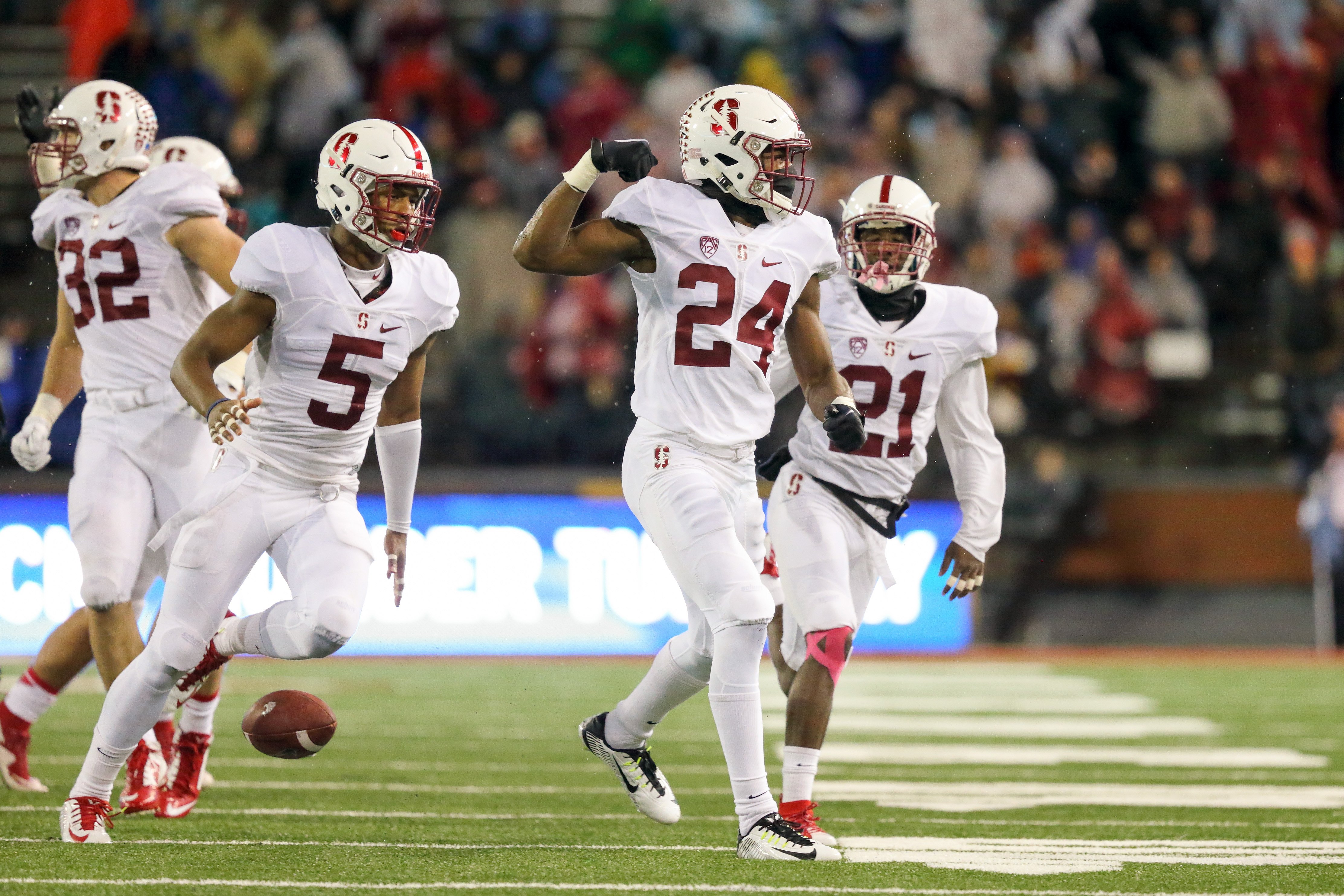“Survive and advance.”
Perhaps no words are more fitting of Stanford’s performance on Saturday night.
Stanford survived against all odds to stay undefeated in conference play. And against all odds, Stanford is still alive in the chase for the College Football Playoff.
To put the cap on an insane evening, Washington State kicker Erik Powell missed wide right from 43 yards on what would have been his sixth field goal of the night. That means that it was the No. 8 Cardinal (7-1, 6-0 Pac-12) that emerged from Martin Stadium as the victors, surviving a thorough scare from Washington State (5-3, 3-2) for a harrowing 30-28 victory on Halloween night.
“I guess miracles do exist,” said fifth-year senior quarterback Kevin Hogan after the game.
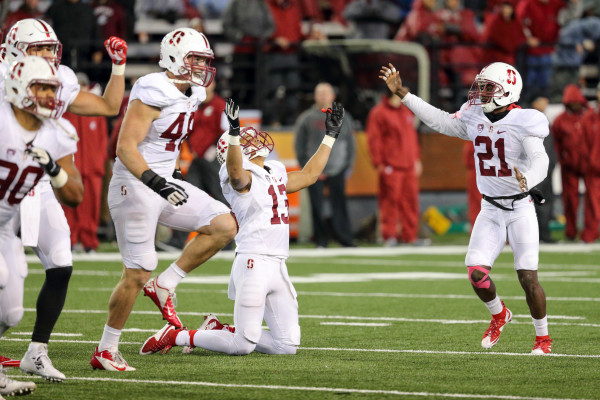
Hogan’s significant contributions to the victory, however, were anything but miracles. Although he had a rough day as a passer, he had the best outing of his career as a runner, leading Stanford in rushing with 112 yards on the ground, including a 59-yard touchdown run, to spur a 27-point surge in the second half after an anemic first half.
“We went to Kevin because nothing else was working,” said head coach David Shaw. “Kevin running was the last thing. I don’t know what we would have done if that didn’t work. Our [shotgun] runs and quarterback read-option plays; those saved our bacon.”
“We won this game because of his heart. To will this team to victory was just phenomenal.”
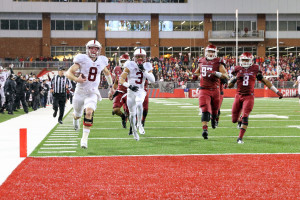
Hogan’s mobility in the second half, paired with a pair of critical late interceptions by freshman nickelback Quenton Meeks and a go-ahead 19-yard field goal by senior Conrad Ukropina, gave the Cardinal just enough to overcome Washington State’s surprisingly stiff defense and unsurprisingly productive offense after Stanford fell into a 12-point deficit.
Meeks, who saw the most action of his young career as Stanford’s first extra defensive back off the bench against Washington State’s aggressive 4-WR and 5-WR sets, had a tremendous day, picking up the first two interceptions of his career with time winding down in the third and fourth quarters.
Both of those late interceptions gave Stanford a short field and set up Cardinal scoring drives.
“We worked so hard as a unit, on defense, to learn about our opponent and what they were going to do,” Meeks said. “I knew exactly what they were doing before they were doing it.
“We don’t win the game without those two interceptions,” Shaw added.
Meeks also finished fourth on the team with 6 tackles on the evening, often matched up one-on-one in space with Washington State’s talented receivers.
In the end, when the team football that Stanford sought to play in the first half didn’t come through, it was the herculean individual efforts of Hogan and Meeks that really pushed the Cardinal over the adversity that it found against the Cougars.
“We needed this game,” Hogan said. “We needed to look adversity in the face and punch it in the mouth.”
That adversity came in the form of Washington State’s defense. Although the unit entered the game last in the Pac-12 allowing 5.06 yards per rush, they dominated the line of scrimmage against Stanford’s offensive line in the first half, with the Cardinal unable to mount any run game and unable to protect Hogan in the pocket.
In fact, Stanford only managed 29 rushing yards on 19 rushes in the first half, and the normally-sound Hogan already had a fumble and an interception to his name due to pressure getting to him more often than not when he dropped back in the pocket.
Meanwhile, although the Stanford defense held Washington State to negative 4 yards of total offense in the first quarter, the Cougars’ offense, led by junior quarterback Luke Falk, finally found its rhythm in the second quarter, scoring on its last four possessions of the quarter to take a 12-3 lead going into the half.
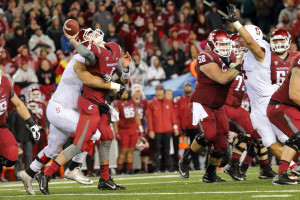
However, key to Stanford’s success was the fact that the defense was able to buckle down in the red zone on all four of those possessions, holding Washington State to field goals on each of those drives to keep the Cougars within striking distance.
“We are going to go back on tape and see we had a lot of opportunities to win this game,” said Washington State head coach Mike Leach. “We did a nice job of competing but we need to convert in those situations. We just did not come away with the win.”
“To be honest, they beat our guys up front,” Shaw said. “A couple times they just beat us one-on-one — on things that we’ve seen before, we just didn’t handle very well… They hit the quarterback multiple times early on in the game and we couldn’t get the running game started either. They were more ready and more prepared than we were.”
To Stanford’s credit, though, it adjusted at halftime and came out of the break as a changed team. Although the Cardinal’s defense still allowed Washington State to score on its first two drives of the second half, Stanford also scored on all four of its third-quarter drives to turn a 15-3 deficit into a 22-20 deficit heading into the fourth quarter.
The biggest of those adjustments was realizing that Washington State was fully overcommitting its defense to stopping McCaffrey, leaving running lanes open for Hogan and allowing for the Stanford quarterback to start eating away at large chunks of yardage on the ground.
And when Hogan’s running started to become a factor, the running lanes opened up for McCaffrey as well. With Hogan rushing for 112 yards and McCaffrey picking up 107 yards on the ground, Stanford had its first game with a pair of 100-yard rushers since 2011.
“We did bounce back,” Hogan said. “It took a while for us to get into a rhythm, but we had a great meeting at halftime. We knew we just needed to settle down and play Stanford football. We came out and had a great drive in the second half and got into a rhythm.”
After fifth-year senior running back Remound Wright got Stanford into the end zone for the first time with a 2-yard touchdown run, Ukropina hit a 32-yard field goal and Hogan added a pair of rushing touchdowns — including his 59-yard run that involved a read-option and juking a cornerback out of his shoes — to give Stanford its first lead of the night at 27-22.
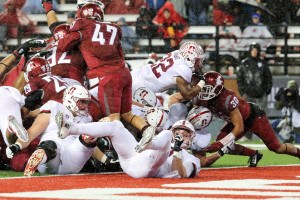
The drive that led to Ukropina’s 32-yard field goal was fraught with controversy, as Washington State fans were dissatisfied with a replay review on a ball that McCaffrey seemed to have fumbled into the arms of a Washington State defender before going down.
While the officials did rule that Stanford would keep the ball, it wasn’t because they said McCaffrey didn’t fumble the ball, as many thought — the ball was clearly out — but because the Washington State’s defender had a foot out of bounds when he recovered, the ball was ruled dead.
After Stanford took its late lead, though, Washington State methodically drove 81 yards to take a 28-27 lead on a touchdown pass from Falk to River Cracraft before the Cougars twice failed on 2-point conversions.
The late Stanford drive to set up Ukropina’s 19-yard go-ahead field goal was punctuated by a 30-yard run to the outside by McCaffrey, setting the stage for the defense to hold on for dear life and limit Washington State to a late long field goal attempt with the ballgame on the line.
“The offense has played its heart out all year and they’ve bailed us out in a couple of games, so it was kind of time for the defense to return the favor,” Meeks said. “That’s what a team is about… When one unit is struggling, the other unit has to pick them up.”
And in the end, despite seemingly everything working against the team in the first half, Stanford did what it needed to do in order to stay undefeated in conference play — with a combination of timely defense, offensive adjustments and a generous pinch of luck.
But the Cardinal will take it.
“It’s a sign of a good team to go on the road, in bad weather, against a team playing its best, and find a way to win,” Shaw said.
“Every team has a game like this. It’s not the way you draw it up, and it took being fortunate.”
Contact Do-Hyoung Park at dhpark ‘at’ stanford.edu.
